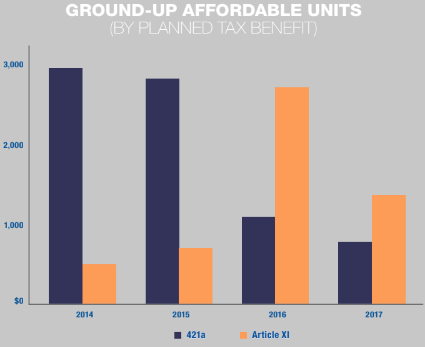Trending
When 421a was in limbo, developers turned to this tax exemption
Ackman-Ziff report shows that Article XI units have outpaced 421a for affordable development during last two years

For roughly 16 months between January 2016 and April 2017, one of developers’ favorite tax exemptions wasn’t an option. Though largely an incentive for market-rate construction, 421a did also subsidize some affordable housing construction; in most buildings that meant 20 percent of the apartments. With 421a gone, however, some developers chose to tap another tax incentive with deeper affordability requirements called Article XI, according to a new report that analyzed affordable housing data from the city.
Article XI awards tax exemptions of up to 40 years for projects that are at least two-thirds affordable, and each project requires the approval of city council. Nearly four times as many Article XI affordable units were planned in New York City during 2016 and 2017 (4,040) than were planned in years 2014 and 2015 (1,187), the report by Ackman-Ziff Real Estate found. Meanwhile, 421a affordable units planned slid dramatically in 2016, as only a select number of new projects were eligible to be grandfathered into the program after it expired.
Marion Jones, a managing director at Ackman-Ziff, said it was no surprise that Article XI development rose when 421a expired.
“If you’re outside of the time frame in which you can be grandfathered in you’re going to start looking at other options,” she said. That includes some market-rate developers who would have ordinarily tapped 421a.
Another of those options found in the report is so called Extremely Low and Low-Income Affordability financing, or ELLA, which is available for buildings with 100 percent low income units. That program has seen a 272 percent increase in units financed since 2015, according to the report, with 1,162 units financed last year.
But somewhat unexpectedly, fewer developers in New York City used Low Income Housing Tax Credits last year: just 3,927 units were produced in 2017, compared to 6,233 in 2014. That program faced an uncertain future for much of 2017 as some congressional budget proposals would have eliminated the program altogether. Ultimately, the lower corporate tax rate passed by Congress in December, reduces tax credit prices and thus the amount of money invested in new units through the LIHTC program. Indeed, prices for credits started dropping long before the reforms went in place. Accounting firm Novogradac & Company has predicted the drop in corporate rate will mean 235,000 affordable homes are built nationwide over the next decade.
Since 421a returned last year, 2,558 apartments have been planned in New York City, though just 96 of them have been completed so far, according to the report.




